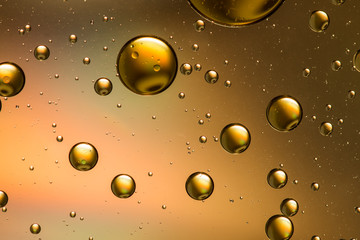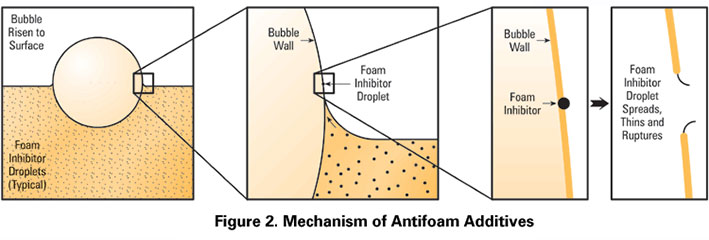
Foam and air entrainment problems are quite common in lubricating oil circulation systems. Problems that may arise as a result of foaming include fluctuations in oil pressure, oil pump cavitation, loss of oil through breathers and dipsticks and decrease in lubrication and cooling efficiencies. The presence of air bubbles in the fluid can also lead to excessive oxidation. In extreme cases foaming can result in the breakdown of a machine or system.
Most lubricating oils are formulated with antifoam additives. Unlike the name of the additive suggests, foam inhibitors do not prevent the formation of air bubbles (aeration) in oil circulating systems. Air is always to a greater or lesser extent present in circulating oil. Foam is a collection of closely packed air bubbles surrounded by thin films of oil. Antifoam oil additives (usually silicone based) work by reducing the film strength of the air bubbles at the oil/air interface. This results in the rupturing of the air bubbles in the oil causing them to break down and agglomerate. The larger bubbles rise more rapidly to the surface of the oil where they burst readily as illustrated below:

Mechanism of Antifoam Additives
The foaming properties of a fluid are usually determined using the ASTM D892 test method, which measures foam by three sequences that differ only in testing temperature:
- Sequence I measures the foaming tendency and stability at 24°C.
- Sequence II measures the foaming tendency and stability at 93.5°C.
- Sequence III uses the same conditions as Sequence I, except that it is performed on the fluid that has just been measured in Sequence II (See Note Below).
Note: The fluid sample from Sequence I is not used in Sequence II. The fluid sample used in Sequence III is the same sample that was used in Sequence II.
The results are reported as two numbers for each sequence. For example: 20/0 means 20 milliliters of foam tendency was measured after 5 minutes of aeration followed by no foam stability (0 ml) after a 10 minute settling time. Most new oil specifications require 10 to 50 milliliters tendency maximum after 5 minutes of aeration and 0 milliliters stability after the 10 minute settling period.
Figure 4

This photo of two oils was taken during the five minute aeration period of the ASTM D892 Foam Test. Excessive foam formation can be seen on the surface of the oil on the left which contained no antifoam additive. The oil on the right was fortified with a foam inhibitor and exhibits negligible foam formation. The photo also shows the larger oil bubbles (that migrate to the surface more readily) in the oil with the antifoam additive.
Although the majority of lubricating oils are formulated with antifoam additives, foam and air entrainment problems are quite common and are usually hard to treat. Traditionally the standard procedure was to run an ASTM D892 foam test on the offending oil, and then indiscriminately add an aftermarket antifoam additive. Generally foam went away quickly, only to return shortly afterwards. More antifoam was added, and the cycle was repeated until the system became so overloaded with foam inhibitor that the oil had to be dumped. Today, there are more practical methods of establishing and treating the source of foam problems and it is therefore usually unnecessary to use aftermarket antifoam additives.
Foaming can be difficult to troubleshoot and for this reason accurate testing to determine the root cause of the problem is essential. The causes of foaming are many. The most common ones include:
- Water contamination.
- Solids contamination.
- Depleted foam inhibitor (possibly due to the use of excessive fine filtration).
- Mechanical issues (causing excessive aeration of the fluid).
- Over- or under-filling of the oil sump/reservoir.
- Cross contamination of the oil with other fluids.
- Contamination of the oil with grease
- Too much antifoam additive by adding aftermarket foam inhibitors.
Although troubleshooting a foaming problem can be challenging, you should be able to identify and correct the root cause through a process of elimination.
If you have any questions regarding foaming or any other lubrication issues, simply mail us at info@bcl.co.za. Our experts are at your disposal and ready to provide you with advice and guidance.
